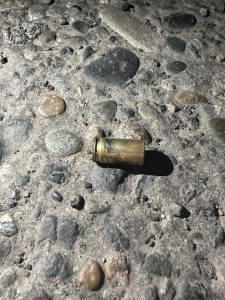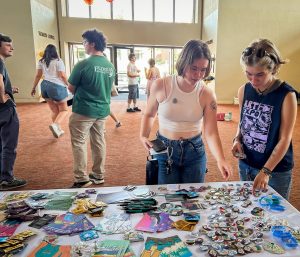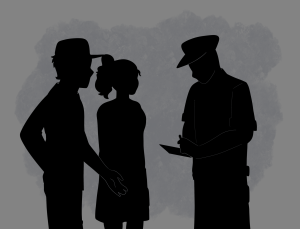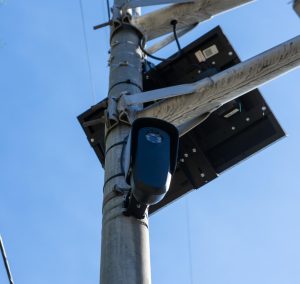Senior Thesis: Research Bringing Students Around the World
March 7, 2019
Genevive Foster: Rethinking the Hawaiian Luau
Genevieve Foster, a senior Anthropology major, is using her personal experience of growing up in Hawaii and her love for creative non-fiction in her thesis which takes the non-traditional form of three creative non-fiction essays focusing on images of the Hawaiian luau.
Each essay explores a different aspect of the image creation of the Hawaiian luau and hula, but overall she hopes to explore how these cultural traditions have become commodified.
“The hotels throughout Hawaii have kind of taken that and commercialized it and turned it into this version of Hawaii that is easily accessible to tourists,” explains Foster.
Within her first essay Foster compares two photographs of the luau that she found through a database of historical magazines. While one photo is an advertisement for a Sheraton Hotel showing the classic image of a hula dancer in a grass skirt on the beach, the other from 1890 shows King Kalakaua’s royal hula troop. However, this hula troop does not match the popularized image of hula.
“Well it’s kind of interesting because it was a traditional hula troop but they’re all dressed in western European clothes. Like one man is wearing a top hat and a monocle and the four women in front of him are wearing tights and buttoned up dresses. But then the background is like a beach background,” Foster said.
Foster emphasized the importance of this royal troop and the history that surrounded them. Before the rule of King Kalakaua in 1833, hula had been outlawed by missionaries and upon being brought to the throne he reintroduced the cultural art form.
“Upon his coronation he brought it back as a celebration of the culture and the history. So it was kind of the symbol of celebration for a tradition, but at the same time in the face of all of this change in Hawaii outside of that. So it was a few years before Hawaii was annexed and then turned into a state and in that in-between period tourism throughout the islands rose. So people were seeing this idea on the mainland and coming to Hawaii wanting this experience they had seen on the mainland,” Foster said.
This creation of a specific image is fascinating to Foster who looks to explore why and how this specific popular image was created.
“I am looking at how the Hawaiian Luau has become what it has become because there are so many directions it could have gone,” Foster said. “So I’m kind of focusing why it has become this hyper sexualized and often very female and just the specific image that comes to anyone’s mind when they think about Hawaii.”
This very specifically curated image is created through the costumes and looks of the dancers, the ambiance of performances, and the locations to name a few factors.
“Another thing that goes into this is the location of these performances. A lot of them are at hotels and are right on the ocean and at sunset times and with lots of palm trees in the background. So it’s a very staged event for the comfort of the tourist. And then separate from the performance itself is the buffet that they have and the hotel staff that come and clear their plates and refill their waters. The kind of creation of the performance for the tourists instead of as an educational thing,” Foster said.
Throughout these essays, Foster draws on her personal experiences of living in Hawaii and learning about the culture in school. The specific performances focused on in her essays is one that was performed at a hotel a few blocks from her childhood home.
“We would always kind of make fun of it a little bit. We were like ‘okay whatever! There are so many better things blah blah blah.’ So I grew up kind of critical of these luaus,” Foster said.
Foster’s criticisms often stemmed from her efforts made throughout her life to learn about the culture of the islands she was living on. At her elementary school Foster learned about Hawaiian culture from learning to gut a fish to participating in hula performances each year. This desire to learn about the place she grew up made this topic a clear choice for Foster.
“I kind of have a lot of complicated feelings about where I grew up and I’m learning as I’m writing this thesis a lot of things that I didn’t know before. So I think it was kind of easy for me to decide on this project because it’s something that I think about all the time,” she explained.
Foster hopes that through her essays which are a more accessible form than the traditional thesis will allow her to give the readers a new look into the complexities of luaus in Hawaii.
“The purpose of this collection of essays for me is to complicate the narrative of the Hawaiian luau because I think everyone has this very specific image that comes to their heads when you say Hawaii even or if you say luau,” Foster said. “Like people dress up as hula dancers for Halloween right and it’s a very stereotypical image and that’s often what I’ve notice that that’s based on like on a lot of pop culture: movies and tv shows and the ads too- that really influences the image people have. So I think what I’m trying to do in these essays is to just complicate that and kind of turn it on its head and kind of talk about how there were so many different directions the luau could have gone.”
Skye Goedert: Environmental Justice and Health in the Marshall Islands
Senior Environmental Studies- Sociology student Skye Goedert is studying the interactions between health, food, the environment and cultural activities on Ebeye Island where she completed an internship and research last summer in the Marshall Islands.
Her internship was working for a camp called Spartan Camp in which the top and bottom five students of every high school were put together to take a variety of classes, have fun and learn new skills such as learning traditional weaving and boat skills. In addition to working for the camp, she was able to conduct research in her spare time.
The history of Ebeye Island is a complicate one or as Goedert started of the interview saying: “Ebeye is kind of like an onion of environmental injustices.”
Beginning after the bombing of Pearl Harbor, the U.S. began their Pacific Island Hopping campaign in the Marshall Islands, which had been previously occupied by Japan. After claiming the islands as U.S. territories, the U.S. began to test nuclear weapons in the area. Of the 118 nuclear tests in the Pacific, 67 took place in the Marshall Islands. The fallout from some of the bomb travelled onto inhabited places.
“The final report said it was an accident, but in 2008 it was uncovered that it was actually on purpose and that they radiated these people on purpose to see what would happen. But it’s still referred to as an accident and the U.S. hasn’t actually confronted this at all,” Goedert explained.
Following the tests, the Marshall Islands were granted a Compact of Free Association (COFA) from which they got independence, were given reparations for nuclear testing, and were given accessibility to immigrate to the U.S. In this deal, the U.S. negotiated to keep a military base on Kwajalein Atoll which is next to the Island of Ebeye. To this day ballistic missiles are tested in the Marshall Islands, causing the evacuation and relocation of people to Ebeye.
“So Ebeye has all of the relocated people from the ballistic missile testing and has some people who were relocated during nuclear testing and it also has people who were coming there for jobs on Kwajalein. Ebeye is a one-mile square island and has 15,000 people on it. The average household is ten and one to two people will feed 20 to 25 people on their salary,” said Goedert.
Due to both the environmental impacts of the nuclear and ballistic missile testing and the resulting density of living on Ebeye, many individuals are getting sick.
“So people are getting sick not only from the nuclear testings and the ballistic missile testings but they’re also getting sick because of like extreme density of the islands. They’re also getting sick from a lot of non-communicable diseases. Like the main one diabetes has a lot to do with food. Food wise after World War II there was this huge shift to imported goods and like it takes three months for anything to get to Ebeye so most of their veggies are wilted and really old and there’s also not a lot of them so they eat a lot of canned food,” explained Goedert.
In addition to health impacts, the displacement and relocation of people has influenced connections to cultural activities such as sailing and fishing.
“Marshallese are super well known for their doubled hulled reversible boats and they have super crazy cool traditional fishing styles. None of my interviewees have ever been on a traditional sailing boat,” Goedert said. “And they talk about how gasoline for new boats is six dollars a gallon and gasoline doesn’t get to the island very often, like I was there for two months and they only got gasoline twice and it was sold out before it even got to the island.”
While Goedert was somewhat of an outsider while studying on Ebeye, she was drawn to studying here do to a similarity of environmental injustices in her own place of origin.
“It actually fit really well because I’m from Okinawa, Japan so where the Pacific Island hopping started, it ended on my island. And my island is 20 percent US military bases so we also have a lot of problems with the US military. So even though I’m a really big outsider in a lot of this I also have some inside knowledge,” Goedert said.
Through her internship, Goedert was allowed many opportunities to witness to work with local and international agencies working on change.
“My host dad was the city manager so he let me come to a bunch of meetings he had which was super cool. So the world bank was there the first week I was there so I got to sit in on that and learned about some of the improvements they’re making there. So they’re trying to make the entire island solar by 2040 and they’re thinking it’s gonna be even sooner,” Goedert said.
Additionally, after completing her internship, Goedert and the other interns travelled to Hawaii for a week to meet with a variety of agencies and officials including a high ranking U.S. government official.
“So basically three steps down from Donald Trump… Met with him! And we talked about kind of the concerns I saw when I was there of the separation between the base and the community on Ebeye and how there wasn’t really a connection, how I didn’t ever really see military personal on Ebeye unless it was for business only and that’s kind of not really a great way to start a community and promote the fact that were not trying to poison them,” Goedert said.
Through her research Goedert has found a huge set of environmental injustices, so many in fact she has had to scale back the scope of her thesis. But most of all what she has observed during her research is the lack of previous studies.
“One of my big things in my thesis is there needs to be more research. A majority of my participants talk about how the ballistic missile testing is causing children to get sick and have headaches and throw up right after the testing, there’s been zero research done,” she explained.
Goedert doesn’t plan to stop with her research here. She will return to Ebeye this summer along with fellow Whitman student Chloe Carothers Liske to work at the summer camp and continue research.
“I’m not done with this project after my thesis,” Goedert said.
Meg Englert: Nepali Female Trekking Guides and Rethinking Western Feminism
Sociology major Meg Englert is writing her thesis on a previous research (ISP) project she did while studying abroad in Nepal. Her thesis focuses on Nepalese female trekking guides and works to negotiate the biases and power structures that were present in her original research.
“I had kind of had these two interests throughout my sociology career at Whitman and those two interests had been: the outdoor industry and sort of the exclusion within the industry in the US and just gender in general. So I decided I would do my ISP on Nepali female trekking guides and it just seemed like the perfect merging of those two interests because women haven’t been in the trekking industry since around 20 years ago and there’s pretty much just one company that started this women only trekking company,” Englert explained.
With these interests Englert contacted the head of the Three Sisters Trekking company in Pokhara, Nepal. She spent a month living in Pokhara alone and interviewing various female guides.
Looking back on her experience of interviewing these guides she now finds that some of her assumptions behind the questions she asked were problematic.
“Because I came in thinking that like ‘oh these women are really trying to start a social movement and they’re trying to push against these super patriarchal structures,’ but their answers to those kind of questions were usually like ‘no I don’t really compare myself to the men in the industry I know that this company is different than the rest of them, but I just feel empowered on my own and not in comparison to men,’” Englert said.
Within her role as an interviewer, there were also power dynamics that affected her interviews greatly.
“I was really concerned about the power dynamic that existed and I knew that I looked just like and probably acted and dressed just like the clients that come to Three Sisters, so it was important for me to make them feel comfortable and not just be another trekker just asking them questions and really grilling them on their lives but really describing to them what I was trying to do and that I was really trying to write about their lives,” said Englert.
Although she was unsure about the ethicality of previously done research, Englert began to consider using it for her senior thesis because she felt that she could reach more rich interpretations with more time.
“I really didn’t expect it to be my thesis necessarily but when I got back to school this past fall and we were told we would have to start figuring out what our thesis would be about I kind of realized that it just didn’t feel finished and it seemed to me that there was a lot more to chew on in my interviews and I hadn’t really been given the opportunity to spend the amount of time that I needed to on the research,” she said.
As she began to consider the possibility of using this research for her thesis she grappled with how to use research that she felt had been done with a Western focused perspective.
“I kind of started this year thinking ‘ok I don’t think this research was ethical’ and I think a lot of my conceptions of the guides were super rooted in Western feminist epistemologies, so I started talking with Michelle Janing, my thesis chair, about how I could navigate that problem and we started finding different theorists that have an anti-western feminist epistemology standpoint. So I started viewing my project through those theorists,” Englert said.
Through using these theorists to look at her research in a new way, she hopes to redefine common Western assumptions surrounding feminism in Nepal.
“In the end my goal is to redefine a lot of words that I was using in a very Western way such as: agency, autonomy, empowerment, feminism — all those sort of hot button terms and sort of figuring out how women are resistant to their societies in ways other than the ways we often conceive them to be in the western world. How women navigate their situation and different ways they feel empowered outside the subordination dynamic we always think of as like sort of the root of feminism,” explained Englert.
Although for Englert it has been a struggle to rethink ways to write her thesis ethically and with the recognition of her previous bias, she says that the process has overall been really rewarding.
“I think it’s been so nice to use this as my thesis because it keeps me connected to my semester and it just helps me to reflect on my time there a lot more. I loved my host family in Nepal and felt really connected to a lot of women that I met, so it’s really nice to feel like I’m doing justice or trying to do justice to the people who gave me their stories,” Englert said.






